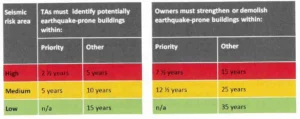The New Zealand Earthquake Prone Building Amendment Act has passed its final reading and was fully enacted on 1 July 2017. All local council policies, procedures and time frames are now superseded by the Act and associated Regulations.
CHANGES
Not much has changed. Basically the idea is to introduce a nationally consistent approach. Areas of high seismicity will have buildings assessed and strengthened faster than areas of low seismicity. The definition, methods of assessing and results will, in essence, remain the same. A national Earthquake Prone Building database will be maintained by the Ministry of Business, Innovation and Employment (MBIE).
DEFINITION OF EARTHQUAKE PRONE
The definition of a moderate earthquake will remain the same. The definition of an Earthquake Prone Building will be altered to better relate to the technical methods of assessing seismic strength.
Previously, the definition required an Earthquake Prone building to exceed its ultimate capacity during a moderate earthquake and be likely to collapse. With current understanding and tools available, Engineers are not able to predict building behaviour beyond ultimate capacity. The regulation will be changed for consideration the consequences if it were to collapse after exceeding ultimate capacity, not requiring that it would necessarily collapse.
” moderate earthquake means, an earthquake that would generate shaking that is one-third as strong as, the earthquake shaking that would be used to design a new building”
A building will also be considered earthquake prone if only part of the building is deemed insufficient to resist a moderate earthquake.
FRAMEWORK
There are three aspects that make up the framework for dealing with Earthquake Prone Building:
The Act is the legal mechanism to make the general rules and responsibilities.
Regulations define the terms.
The EQB Methodology is set by the chief executive of MBIE and has regulatory status.
The methodology is effectively a national replacement previous local authority policies. It cites the engineering guidelines in accordance with which seismic assessments are to be completed. Previously, engineering guidelines had no regulatory status.
THE ROLE OF COUNCILS (TA)
Territorial Authorities will be required to identify potentially Earthquake Prone Buildings – spread throughout the timeframe available. Owners will be given the opportunity to respond and/or complete their own assessment before the building rating is confirmed by the TA. Buildings cannot be deemed Earthquake Prone (or not) by a privately engaged Engineer. The TA will then issue a notice to remediate within a certain time frame. Earthquake Prone Buildings will be put onto a public national register. The register shows buildings which are considered Earthquake Prone but does not show whether a building as been assessed or not.
TIMELINES
The country has been split into three seismic zones. The zones are defined in terms of the seismicity used to design new buildings. The three zones are:
High: Christchurch, Gisborne, Hastings, Napier, Palmerston North, Queenstown, Wellington (Z≥0.3)
Medium: Hamilton, Invercargill, Nelson, New Plymouth, Tauranga, Timaru, Whanganui (0.15≤Z<0.3)
Low: Auckland, Dunedin, Oamaru, Whangarei (Z<0.15)

Priority buildings will be those that:
- are critical to emergency response (hospitals, fire/police/ambulance stations)
- house vulnerable groups (schools, prisons)
- could block strategic routes
- have unreinforced masonry that could fall onto a public road, footpath or thoroughfare (affecting public safety)
WHAT DO YOU NEED TO DO?
Not much has changed, business as usual. Earthquake prone buildings still require identification and strengthening or demolition within a certain time frame.

BUILDING OWNERS
Understand your building. You can proactively collect information, commission an engineering report and start strengthening. Gain advice about the timeframes available in your region of New Zealand. If the Council send notice, you can submit any evidence previously gathered.
PURCHASING A BUILDING
Understand the engineering assessment process (see guidance from MBIE, SESOC and NZSEE). Commission your own engineering assessment or request one from the vendor. Consider if there is appropriate certainty of the assessment results to support an investment decision.
TENANTING A BUILDING
Don’t unnecessarily over-specify a strength rating, you will pay for building upgrades in your lease.
Buildings that are at least 1/3 the strength of the new building standard are not “Earthquake Prone”
The annual risk of dying in a 1/3 earthquake strength building is, using present statistical analysis of available information, about the same as dying in a building fire or during a return plane flight. The government has set the 1/3 threshold as an acceptable limit. It’s up to you whether you’re comfortable with occupying a minimum strength building.
BUSINESS CONTINUITY
Understand that Earthquake Prone Building legislation and all normal forms of seismic assessment consider only life safety during a moderate earthquake. The building might be rated 100%, A+ for life safety during a moderate earthquake. Great, we all live!
What happens if you get a larger earthquake, like Christchurch did? What if the building requires demolition after a moderate earthquake? The monetary and non-monetary cost of business interruption from an earthquake is significant. Commission a special seismic assessment that considers risk of structural and non-structural damage – predict cost and repair time for various probabilistic scenarios.
More information can be accessed from the MBIE website: New framework for managing earthquake-prone buildings
This article contains personal opinions and is not representative of any organisation.


